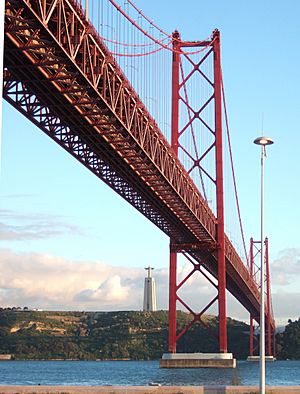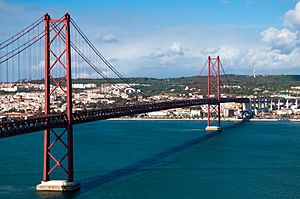25 de Abril Bridge facts for kids
Quick facts for kids Ponte 25 de Abril |
|
|---|---|

View with the Christ the King Sanctuary
|
|
| Coordinates | 38°41′21″N 09°10′37″W / 38.68917°N 9.17694°W |
| Carries | Six road lanes of IP 7 A 2 Two railway tracks of Linha do Sul |
| Crosses | Tagus River |
| Locale | Lisbon (right/North bank) Pragal (left/South bank) |
| Official name | Ponte 25 de Abril |
| Other name(s) | Ponte Salazar (before 1974) Tagus River Bridge |
| Maintained by | Lusoponte [1] |
| Characteristics | |
| Design | Suspension |
| Total length | 2.277 kilometres (1.415 mi) |
| Longest span | 1,012.88 m |
| Clearance below | 70 m at mean high water |
| History | |
| Opened | 6 August 1966 |
| Statistics | |
| Daily traffic | 150,000 cars 157 trains |
| Toll | 2 € (northbound only) |
The 25 de Abril Bridge (which means "25th of April Bridge" in Portuguese) is a very important suspension bridge in Portugal. It connects the capital city, Lisbon, on the north side of the Tagus River, to the town of Almada on the south side. The bridge is about 2.277 kilometers (1.4 miles) long. This makes it one of the longest suspension bridges in the world.
When it first opened on August 6, 1966, it was called the Salazar Bridge. This was named after the Prime Minister at the time, António de Oliveira Salazar. However, after the Carnation Revolution in 1974, which changed Portugal's government, the bridge was renamed to honor April 25th, the day the revolution happened. People also often call it the Tagus River Bridge.
Over the years, the bridge has been updated because more and more people use it. In the 1990s, an extra car lane was added. In 1999, a lower level was finally built for railway tracks, which had been planned from the start. Today, the top level has six lanes for cars, and the bottom level has two railway tracks.
Contents
Building the Bridge
Early Ideas for a Bridge
People started talking about building a bridge across the Tagus River way back in the late 1800s. In 1929, an engineer named António Bello asked the government if he could build a railway bridge. This bridge would connect Lisbon and Montijo.
In 1933, a special group was formed to look into this idea. They suggested building a bridge for both cars and trains. However, this plan was put aside for a while. Instead, they decided to build a bridge further north, at Vila Franca de Xira.
Planning and Construction Starts
In 1953, a new government group began working on the bridge project again. By 1958, they decided to build the bridge where it is now. They chose a spot near the Christ the King monument in Almada.
In 1959, four companies from around the world offered to build the bridge. In 1960, a group led by the United States Steel Export Company won the bid. Many American engineers came to Portugal to work on the bridge. The Carlucci American International School of Lisbon was even started to educate their children.
Building the bridge began on November 5, 1962. It was finished very quickly, in just 45 months! This was six months ahead of schedule. The bridge officially opened on August 6, 1966. The President of Portugal, Admiral Américo Tomás, and Prime Minister António de Oliveira Salazar were there. The bridge was named Salazar Bridge at this ceremony.
The main company in charge of building the bridge was United States Steel International Inc. An American company called Morrison-Knudsen of Portugal Ltd. also helped a lot. They had worked on the San Francisco Bay Bridge before. The bridge was designed by famous engineering companies from New York and San Francisco. The steel used to build it came from the United States. About 3,000 people worked on the bridge, and sadly, four workers died during its construction.
Renaming the Bridge
Soon after the Carnation Revolution in 1974, the bridge was renamed the 25 de Abril Bridge. This was to celebrate the day the revolution happened. There's a famous image from that time showing people removing the big brass letters that spelled "Salazar" from the bridge. They then painted "25 de Abril" in its place.
Bridge Expansion and Changes
Adding More Lanes
The top part of the bridge, which is about 70 meters (230 feet) above the water, first had four car lanes. These were two lanes going in each direction. On July 23, 1990, a fifth lane was added. This lane could change direction depending on traffic. Then, on November 6, 1998, the bridge was made wider and stronger to fit six car lanes.
Cars crossing the bridge often hear a unique humming sound. This is because the two inner lanes are made of a metal grate instead of asphalt. This design helps reduce wind forces on the bridge.
Adding the Railway
Since June 30, 1999, the lower part of the bridge has carried a double railway track. To make this possible, the bridge needed a lot of extra support. New main cables were added above the old ones, and the main towers were made taller. The railway was actually part of the first design plan, but it was removed to save money. The original company that built the bridge, American Bridge Company, was called back to do this big job.
Even with more lanes and the railway, traffic on the bridge grew much faster than expected. It often reaches its maximum capacity. A second bridge in Lisbon, the Vasco da Gama Bridge, was built to help, but the 25 de Abril Bridge is still very busy.
The Bridge in Popular Culture
The 25 de Abril Bridge has appeared in several movies. Some scenes from the 1969 James Bond film On Her Majesty's Secret Service were filmed on the bridge. James Bond drives across it in his Aston Martin in the movie.
Normally, people cannot walk across the bridge. However, every year there is a Lisbon Half Marathon. This race starts on the south side of the river and finishes on the north side, allowing runners to cross the bridge.
In September 2017, a special viewing platform was built. It's called the Pilar 7 Bridge Experience. This allows people to go up and see amazing views from the bridge's structure.
Tolls for Crossing
You have always had to pay a toll to cross the 25 de Abril Bridge. At first, you paid in both directions. Since 1993, you only pay when traveling north, into Lisbon. The place where you pay the toll is on the south side of the Tagus River.
The tolls have caused some arguments over the years. The bridge was supposed to be paid off in 20 years. After that, it was meant to be free or have a much lower toll. However, the government kept charging tolls for much longer. Then, they gave the right to collect tolls to a private company called Lusoponte. This company also manages the Vasco da Gama Bridge.
When the bridge first opened, people had to get out of their cars to buy a toll ticket. In 1994, the government raised the toll by 50%. This was to prepare for giving the bridge to Lusoponte for 40 years, starting in 1996. This increase made many people angry, and there were protests and road blockades. Today, the toll for a regular car going northbound into Lisbon is €1.85 (as of March 2020). There is no toll for going southbound.
The agreement with Lusoponte is set to end on March 24, 2030. After that, the bridge will be managed by the state again.
Bridge Design and Similarities
The design of the 25 de Abril Bridge was partly inspired by two famous bridges in the San Francisco Bay Area in the United States. Its paint is the same bright orange color as the famous Golden Gate Bridge. Its design is also similar to the San Francisco–Oakland Bay Bridge. Interestingly, both the Bay Bridge and the 25 de Abril Bridge were built by the same company.
Engineers say that like the San Francisco–Oakland Bay Bridge, the 25 de Abril Bridge is in an area where earthquakes can happen. So, its design had to be very strong to handle them. Another bridge that shares a similar design is the Forth Road Bridge in Edinburgh, Scotland.
When it was finished, the 25 de Abril Bridge had some impressive records. It had the longest suspended span and the longest main span in Europe. It also had the world's longest continuous truss and the deepest bridge foundation. It was the fifth-largest suspension bridge in the world and the largest outside the United States. Today, it is still one of the largest suspension bridges globally.
Bridge Facts and Figures
As of 2006, about 150,000 cars cross the bridge every day. During busy times, about 7,000 cars cross each hour. The railway is also very busy, with an average of 157 trains crossing daily. In total, around 380,000 people cross the bridge every day.
Here are some other interesting numbers about the bridge:
- 1,012.88 meters (3,323.1 feet) – length of the main span (the longest part hanging between the towers)
- 2,277.64 meters (7,472.6 feet) – total length of the main structure
- 70 meters (230 feet) – height from the water to the upper car platform
- 190.47 meters (624.9 feet) – height of the main towers (making them the seventh tallest structure in Portugal)
- 58.6 centimeters (23.1 inches) – thickness of each of the two sets of main cables
- 11,248 – number of steel wires in each set of main cables (each wire is about 4.87 mm thick)
- 54,196 kilometers (33,676 miles) – total length of all the steel wires in the main cables
- 79.3 meters (260 feet) – how deep the foundation of the south pillar goes below the water
- 30 kilometers (19 miles) – length of the roads that lead to the bridge
- 32 – number of smaller bridges (viaducts) on the access roads
See also
 In Spanish: Puente 25 de Abril para niños
In Spanish: Puente 25 de Abril para niños
- Vasco da Gama Bridge, another important bridge serving Lisbon




